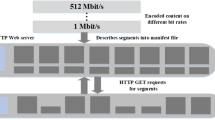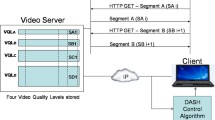Abstract
Among metrics that highly affect video quality and quality of experience (QoE), we can cite the stalling and the visual quality caused by mobile network overhead. Moreover, Dynamic Adaptive Streaming over HTTP (DASH) is widely used for video streaming to adapt the video in the current network conditions and improve the bandwidth utilization. In fact, a good rate adaptation algorithm is a novel technology can easily ameliorate the user perception and the quality of video. Although, several researches innocently estimate bandwidth from a one-sided client perspective, without taking into account other devices in the network. This behavior can trains in inequity and could potentially lower QoE for all clients. In this paper, we propose a novel approach based on Software Defined Network and DASH in order to reduce the stalling events during the video that aims to fairly enhance the QoE of multiple competing clients in a shared network environment. To do this, we first propose architecture to improve the user perception for a single user and in a second point; we generalize the proposed method for all users demanding a video service. The performance evaluation is conducted by using network simulator and the obtained results show that our approach can give significant gain in terms of user satisfaction.














Similar content being viewed by others
References
ITU-T Recommendation P.910. (2008). Subjective video quality assessment methods for multimedia applications.
Letaifa, A. B. (2018). Real time ml-based qoe adaptive approach in SDN context for HTTP video services. Wireless Personal Communications, 103, 2633–2656. https://doi.org/10.1007/s11277-018-5952-6.
Shao, H., Lu, Z., Wen, X., Zhang, H., Chen, Y., & Hong, Y. (2016). Content-aware video QoE coverage analysis in heterogeneous wireless networks. Wireless Personal Communications, 90, 487–502. https://doi.org/10.1007/s11277-015-3073-z.
Pokhrel, J. (2014). Intelligent quality of experience (QoE) analysis of network served multimedia and web contents (Doctoral dissertation).
Yuan, H., Hu, X., Hou, J., Wei, X., & Kwong, S. (2019). An Ensemble Rate Adaptation Framework for Dynamic Adaptive Streaming Over HTTP. IEEE Transactions on. Broadcasting.
De Cicco, L., Manfredi, G., Mascolo, S., & Palmisano, V. (2019). QoE-fair resource allocation for DASH video delivery systems. In Proceedings of the 1st International Workshop on Fairness, Accountability, and Transparency in MultiMedia (pp. 33–39).
Akhshabi, S., Anantakrishnan, L., Begen, A. C., & Dovrolis, C. (2012). What happens when HTTP adaptive streaming players compete for bandwidth?. In Proceedings of the 22nd international workshop on Network and Operating System Support for Digital Audio and Video (pp. 9–14).
Amin, R., Reisslein, M., & Shah, N. (2018). Hybrid SDN networks: A survey of existing approaches. IEEE Communications Surveys & Tutorials, 20(4), 3259–3306.
Abar, T., Letaifa, A. B., & El Asmi, S. (2017, June). Objective and subjective measurement QOE in SDN networks. In 2017 13th International Wireless Communications and Mobile Computing Conference (IWCMC) (1404-1406). IEEE.
Husić, J. B., Baraković, S., & Osmanović, I. (2019). Subjective and objective QoE measurement for H. 265/HEVC video streaming over LTE. In International Symposium on Innovative and Interdisciplinary Applications of Advanced Technologies (pp. 428–441). Springer, Cham.
Laghari, A. A., He, H., Zardari, S., & Shafiq, M. (2017). Systematic analysis of quality of experience (QoE) frameworks for multimedia services. IJCSNS, 17(5), 121.
ITU-T SG12. (2007) Definition of Quality of Experience. TD 109rev2 (PLEN/12), Geneva.
Spachos, P., Lin, T., Li, W., Chignell, M., Leon-Garcia, A., Jiang, J., & Zucherman, L. (2017). Subjective QoE assessment on video service: Laboratory controllable approach. In 2017 IEEE 18th International Symposium on A World of Wireless, Mobile and Multimedia Networks (WoWMoM) (pp. 1–9). IEEE.
Abar, T., Letaifa, A. B., & Asmi, S. E. (2020). Quality of experience prediction model for video streaming in SDN networks. International Journal of Wireless and Mobile Computing, 18(1), 59–70.
Kua, J., Armitage, G., & Branch, P. (2017). A survey of rate adaptation techniques for dynamic adaptive streaming over HTTP. IEEE Communications Surveys & Tutorials, 19(3), 1842–1866.
ISO/IEC IS 23009-1. (2012) Information technology-dynamic adaptive streaming over HTTP (DASH)-Part 1: Media presentation description and segment formats.
Triki, I., El-Azouzi, R., Haddad, M., Zhu, Q., & Xu, Z. (2017). Learning from experience: A dynamic closed-loop QoE optimization for video adaptation and delivery. In 2017 IEEE 28th Annual International Symposium on Personal, Indoor, and Mobile Radio Communications (PIMRC) (pp. 1–5). IEEE.
Mangla, T., Halepovic, E., Ammar, M., & Zegura, E. (2019). Using Session Modeling to Estimate HTTP-Based Video QoE Metrics from Encrypted Network Traffic. IEEE Transactions on Network and Service Management, 16(3), 1086–1099.
Moldovan, C., Wamser, F., & Hoßfeld, T. (2019). User behavior and engagement of a mobile video streaming user from crowdsourced measurements. In 2019 Eleventh International Conference on Quality of Multimedia Experience (QoMEX) (pp. 1–3). IEEE.
Ghani, R. F., & Ajrash, A. S. (2018). Quality of experience metric of streaming video: A survey. Iraqi Journal of Science, 59(3B), 1531–1537.
Yarnagula, H. K., Juluri, P., Mehr, S. K., Tamarapalli, V., & Medhi, D. (2019). QoE for mobile clients with segment-aware rate adaptation algorithm (SARA) for DASH video streaming. ACM Transactions on Multimedia Computing, Communications, and Applications (TOMM), 15(2), 1–23.
Mok, R. K., Luo, X., Chan, E. W., & Chang, R. K. (2012). QDASH: A QoE-aware DASH system. In Proceedings of the 3rd Multimedia Systems Conference (pp. 11–22).
Ramakrishnan, S., Zhu, X., Chan, F., & Kambhatla, K. (2015). SDN based QoE optimization for HTTP-based adaptive video streaming. In 2015 IEEE International Symposium on Multimedia (ISM) (pp. 120–123). IEEE.
Georgopoulos, P., Elkhatib, Y., Broadbent, M., Mu, M., & Race, N. (2013). Towards network-wide QoE fairness using openflow-assisted adaptive video streaming. In Proceedings of the 2013 ACM SIGCOMM workshop on future human-centric multimedia networking (pp. 15–20).
Li, W., Meng, W., & Kwok, L. F. (2016). A survey on openflow-based software defined networks: Security challenges and countermeasures. Journal of Network and Computer Applications, 68, 126–139.
Kleinrouweler, J. W. (2017). Enhancing over-the-top video streaming quality with DASH assisting network elements. In Adjunct Publication of the 2017 ACM International Conference on Interactive Experiences for TV and Online Video (pp. 113–116).
Zou, L., Bi, T., & Muntean, G. M. (2019). A DASH-based adaptive multiple sensorial content delivery solution for improved user quality of experience. IEEE Access, 7, 89172–89187.
Bokani, A., Hassan, M., & Kanhere, S. (2013). HTTP-based adaptive streaming for mobile clients using Markov decision process. In 2013 20th International Packet Video Workshop (pp. 1–8). IEEE.
Nightingale, J., Salva-Garcia, P., Calero, J. M. A., & Wang, Q. (2018). 5G-QoE: QoE modelling for ultra-HD video streaming in 5G networks. IEEE Transactions on Broadcasting, 64(2), 621–634.
Bokani, A., Hassan, M., Kanhere, S., & Zhu, X. (2015). Optimizing HTTP-based adaptive streaming in vehicular environment using markov decision process. IEEE Transactions on Multimedia, 17(12), 2297–2309.
Hu, S., Xu, M., Zhang, H., Xiao, C., & Gui, C. (2019). Affective content-aware adaptation scheme on QoE optimization of adaptive streaming over HTTP. ACM Transactions on Multimedia Computing, Communications, and Applications (TOMM), 15, 1–18.
Abar, T., Letaifa, A. B., & El Asmi, S. (2018). How modeling QoE requirements using game theory. In 2018 32nd International Conference on Advanced Information Networking and Applications Workshops (WAINA) (pp. 147–152). IEEE.
Tan, X., Gustafsson, J., & Heikkilä, G. (2006). Perceived video streaming quality under initial buffering and rebuffering degradations. In MESAQIN Conference (2006) (Vol. 90).
NTIA VQM. (2017). http://www.its.bldrdoc.gov/vqm December 2017.
Letaifa, A. B. (2019). SSIM and ML based QoE enhancement approach in SDN context. Advances in Computers, 151.
Mininet. http://mininet.org/.
RYU SDN Framework. http://osrg.github.io/ryu/
Weka tool: https://www.cs.waikato.ac.nz/ml/weka/
Abar, T., Letaifa, A. B., & El Asmi, S. (2017). Machine learning based QoE prediction in SDN networks. In 2017 13th International Wireless Communications and Mobile Computing Conference (IWCMC) (pp. 1395–1400). IEEE.
Big BuckBunny: https://peach.blender.org/.
Author information
Authors and Affiliations
Corresponding author
Additional information
Publisher's Note
Springer Nature remains neutral with regard to jurisdictional claims in published maps and institutional affiliations.
Rights and permissions
About this article
Cite this article
Abar, T., Ben Letaifa, A. & El Asmi, S. Heterogeneous Multiuser QoE Enhancement Over DASH in SDN Networks. Wireless Pers Commun 114, 2975–3001 (2020). https://doi.org/10.1007/s11277-020-07513-w
Published:
Issue Date:
DOI: https://doi.org/10.1007/s11277-020-07513-w




